In this article, you’ll learn what is timing belt in car and how it works? Its Diagram, Symptoms, and Replacement are explained.
You can also download the PDF file of this article at the end.
What is Timing Belt In Car?
A car timing belt is a very important part that keeps the I.C. engine running. It spins around the end of various shafts in the car to transfer the rotational energy in one direction to turn the wheels.
It is used to synchronize the rotation of the crankshaft and camshaft so that the engine valves open and close at the appropriate time during each intake and exhaust stroke.
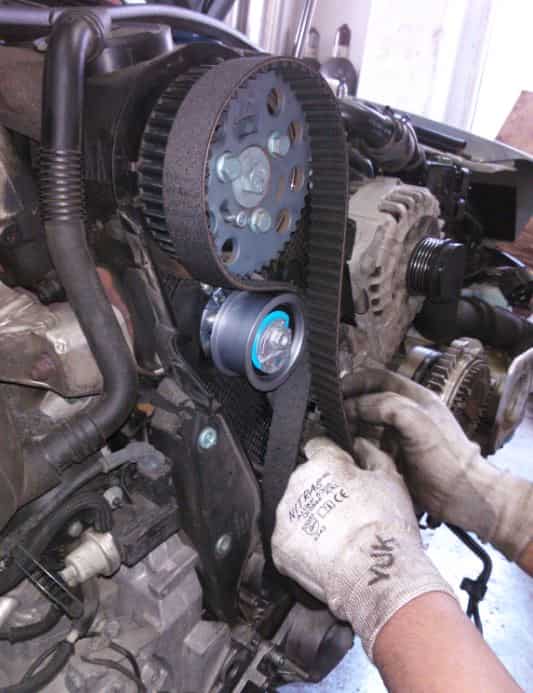
The timing belt is typically a rubber belt that uses a belt drive mechanism and has a number of teeth on the inside surface. These teeth are useful for increasing the grip on the heads of various shafts within the engine.
In many modern engines, the timing belt is used to synchronize the camshaft and crankshaft rotation. But some engines use gears to drive the camshaft.
Working of Timing Belt
The basic working of the timing belt is that it connects the crankshaft to the camshaft. In addition, it also plays an important role to control the pistons and valves of the engine. As the crankshaft turns, the timing belt rotates the camshaft and opens or closes each valve, and allows the pistons to move up and down.
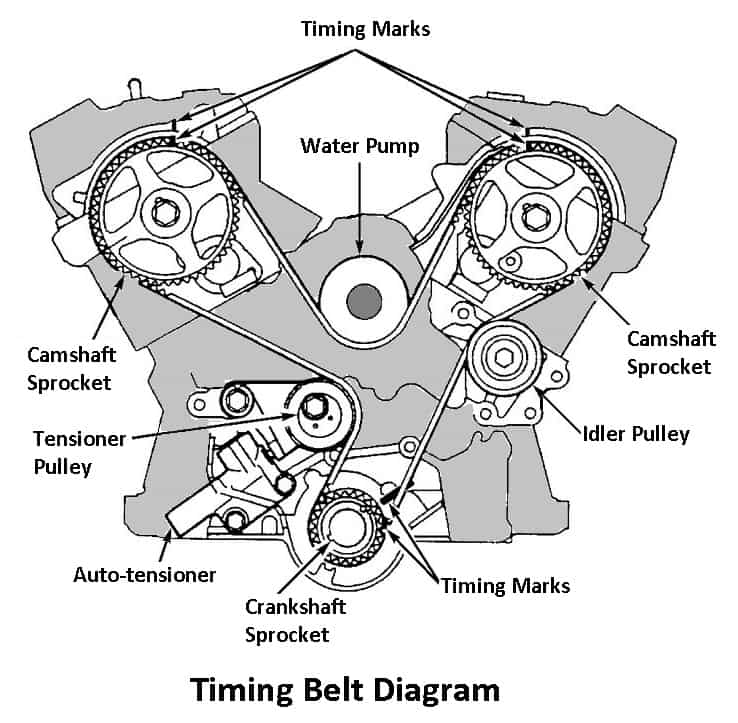
For example, consider a four-stroke engine. The four strokes are intake, compression, combustion, and exhaust stroke. In the intake stroke, the inlet valves are open, through which the air/fuel mixture enters the engine. In the compression and combustion stroke, the air/fuel mixture is compressed and ignited by the spark plug. Finally, In the exhaust stroke, the air/fuel is sent out of the cylinder through the exhaust valve.
In this case, the timing belt controls the timing of the opening and closing of all valves and pistons during each stroke with a precise sequence.
Why Timing Belt Is Needed?
These belts are made of rubber with hard tooths that engage with the cogwheel of the crankshaft and camshaft. The crankshaft operates to move the piston and the camshaft operates the valves to let in and out air or gas.
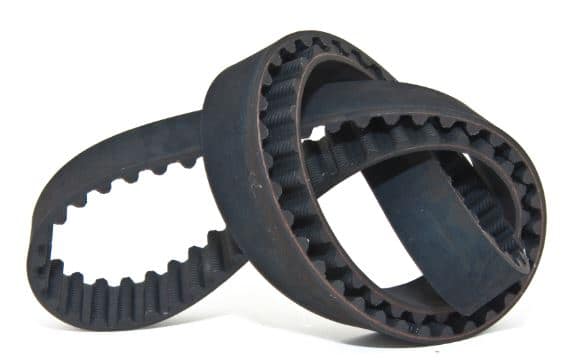
If these two systems do not work properly, damage may occur to the valves, pistons, engine, or other surrounding parts. The timing belt works to ensure each system is kept running at the correct rate.
This is important because, as the fuel is being ignited in the combustion chamber, the engine controls the air/fuel mixture by pushing the piston up and down. Therefore, no matter whether you are driving a new car or an old car, you need to make sure that you have a proper working timing belt.
Timing Belt Symptoms
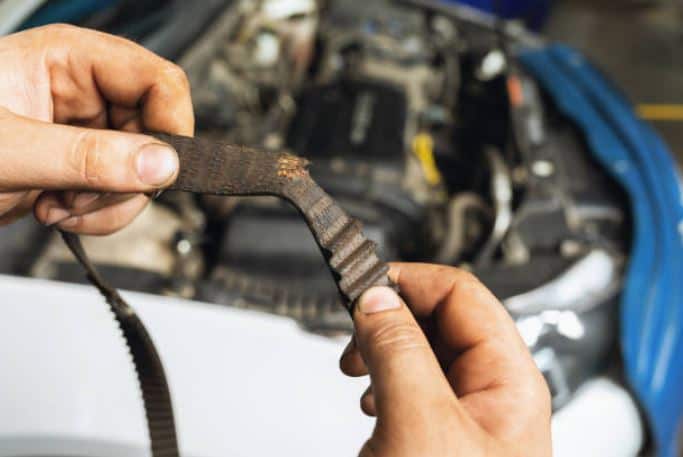
If the engine timing belt of your car has worn out, the following symptoms may occur. Once you experience any of these symptoms, call a technician or mechanic to inspect the belt and replace it if necessary.
- Engine oil pressure dropping
- Noise from engine
- Engine misfiring
- Smoky exhaust
- Engine won’t turn over
- Piston and valve get broken
- Rough idling
#1 Engine Oil Pressure Dropping

Usually, the timing belt spins the gears of the camshaft at the correct time. If the timing belt gets fail, it can lead to the timing of the camshaft being off. This causes the camshaft pieces to break off and fall into the oil pan, resulting in reduced oil pressure in the bottom of the engine.
This is one of the worst symptoms that can happen if your belt fails because of the low oil pressure in the engine. In addition, this will cause the engine to fail completely. The only way to avoid this symptom is by rebuilding the entire motor.
#2 Noise From Engine

The engine timing belt is usually connected to the series of pulleys of the crankshaft and camshaft. The crankshaft controls the engine’s connecting rods, which are attached to pistons inside the combustion chamber.
While the camshaft cylinder head valves and rocker arm assembly. This sends fuel into the combustion chamber and forces the burnt gases out of the exhaust manifold. So when the timing belt wears out, it creates a ticking noise inside the engine. It also occurs due to the belt loosening.
#3 Engine Misfiring
A worn timing belt can also affect the engine’s rate of fire. This happens when the timing belt slips and falls out of gear onto the camshaft. This causes the engine cylinders to open and close very quickly.
This may seem harmless, if the belt is not repaired and continues the misfires regularly, then it causes permanent damage to the engine.
#4 Smoky Exhaust
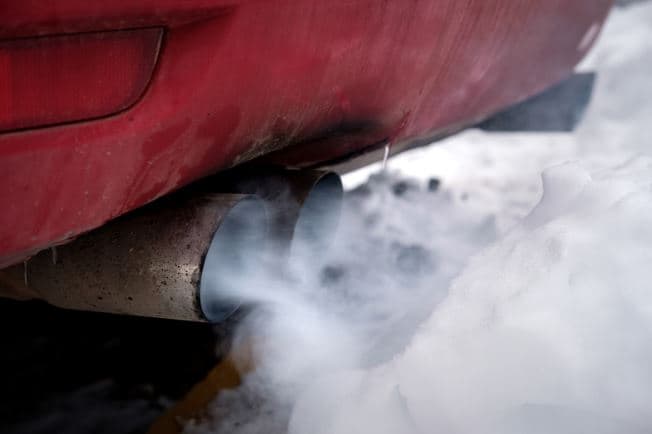
If your car engine exhaust is emitting more smoke than before, it could be related to your timing belt problem. Usually what happens is, there are two holes in the top of each cylinder that are responsible for pushing the exhaust out and letting air in.
The opening and closing of these holes are synchronized with the movement of the cylinder and the rotation of the camshaft. If your engine timing belt is worn out it will become unsynchronized, resulting in exhaust leaking out and letting air in at inappropriate times. This can cause your engine to work harder which can lead to costly repairs.
#5 Engine Won’t Turn Over
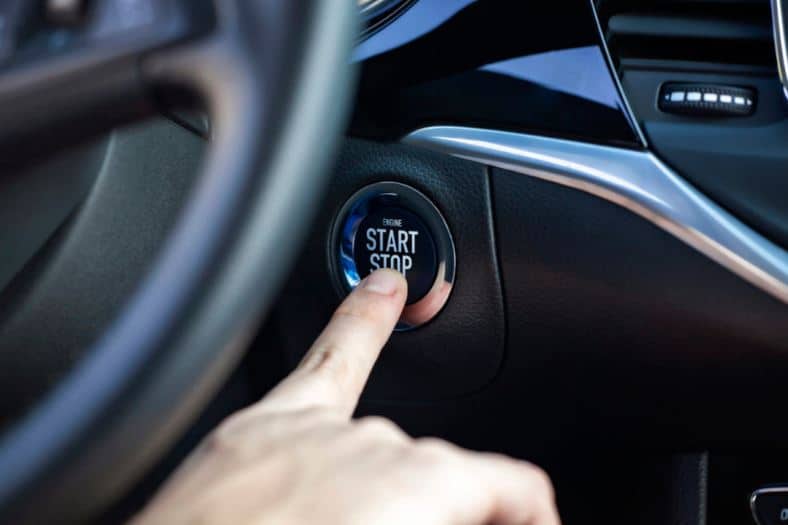
If you have a bad timing belt, the engine will not be able to start or ignite. When you turn the key to start your vehicle, you may hear the starter motor engage but the engine will not start.
This means that when your timing belt breaks, you will not be able to drive your car to move from a certain position. Sometimes the timing belt will break while you driving your car, causing serious damage to cylinder head hardware such as the rocker arm, pushrod, or valves.
#6 Piston and Valves Get Broken
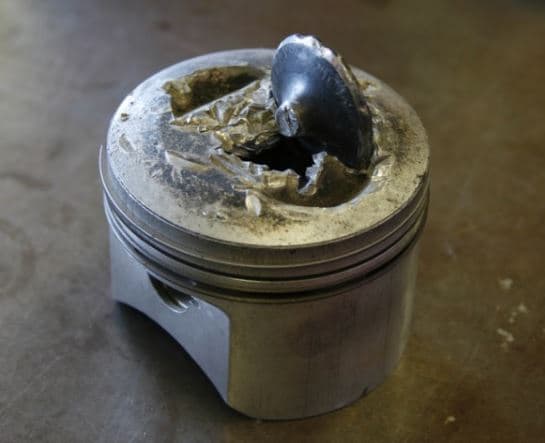
This is the worst symptom that occurs due to the failure of the timing belt. If this happens, the crankshaft will turn automatically and will not keep the sync with the movement of the camshaft.
Because of that, the pistons will come into contact with the valves as they open and eventually bend the valves or damage the pistons. Once you experience this symptom, immediately shut down the engine to prevent further damage.
#7 Rough Idling
Timing belts typically have teeth on the inside surface to hold the gears in place as they are rotating various engine parts and components. If these teeth ever start to fall out or become brittle, the timing belt will slip out of the gear.
These teeth will fall directly on the gear and this can lead to “jump a tooth” causing a loss of power to your vehicle. Once this happens, the engine will start to stall and may get failure.
How To Check If Timing Belt Is Worn?
Due to the continuous and massive power under which a timing belt works, it may get worn sometimes. Therefore it is necessary to change or inspect it regularly.
Following are the simple steps you can take to inspect the timing belts:
- Firstly, you need to look at the outer surface of the belt to see if it has small cracks.
- One or two small cracks in the outer layer of the belt are fine, but if it has too many cracks on its surface it can cause excessive wear.
- After that, flip the belt over a bit to inspect the teeth. In fact, you can’t “flip” the belt, but you can see the underside of the belt all the way around.
- A single broken tooth can be destructive, as it can lead to something called “jump the timing.” If this happens, the engine’s spark plugs and valves don’t work properly, and your engine will run very poorly.
- In addition, you can also check the elasticity of the belt by twisting it. If it turns in more than half that, there may be too much free elasticity in it.
- Finally, check your car’s manual guide to see if there are any other options for inspecting the belt.
Timing Belt Replacement
To replace a timing belt requires a decent understanding of engines. It becomes quite easy for you to fix it if you are well experienced. Do not stop changing the timing belt. If it cracks or breaks, you could be looking at some serious repair bills.
The following steps are taken to replace the timing belt:
- There are two belts (fan belt and power steering belt) which houses the timing belt and water pump. so you have to remove them first to take out the timing belt.
- Now, you’ll need to remove the timing case and crankshaft pulley which covers the timing belt.
- Before loosening the crankshaft pulley, it’s good to mark the cogs with chalk. Because this will make the reassembly a lot easier.
- At this point, you have a clear approach to removing the timing belt.
- After that you will need to remove the water pump. Before doing this, make sure you have a bucket under the car to catch coolant.
- Now you can reassemble the engine with the new water pump and timing belt.
- Finally, refill the cooling system with a new high-performance coolant.
Checkout the article for: Detailed Explanation in Timing Belt Replacement
Closing It Up
Timing belts are usually made of rubber with tension that helps to rotate the various components in an engine. For it to function properly, it needs to be replaced every 60,000-100,000 miles.
There are varieties of belts and every manufacturer is different, so we recommend that you contact a mechanic or you can refer to your car manual for more information on replacement.
So for now, I hope I’ve covered everything about “Timing Belt In Car“. If you still have any doubts or questions on this topic, you can contact us or ask in the comments. If you like this article then please share it with your friends.
Want free PDFs direct to your inbox? Then subscribe to our newsletter.
Download PDF of this article:
Check out these useful resources:
- What are the different types of car interior parts? [Working & Uses]
- How many types of transmission systems are used in vehicle?
The above used all images are under creative common liecenses.
I am interested please send me pdf download link
The PDF file has been sent to your inbox.
Can I get the full pdf.
The PDF file has been sent to your inbox.
Can you please send me the pdf
The PDF file has been sent to your inbox.
Send pdf please
The PDF file has been sent to your inbox.
Please send me PDF ro download. Thank you
The PDF file has been sent to your inbox.
Can I also have the PDF please
The PDF file has been sent to your inbox.
May I have to PDF Sir? Thank you.
The PDF file has been sent to your inbox.
A very helpful note.may I hv pdf plz
The PDF file has been sent to your inbox.
Can I also have the PDF please
The PDF file has been sent to your inbox.
Can you please send the pdf
The PDF file has been sent to your inbox.
Could you please sent me a pdf
The PDF file has been sent to your inbox.
That is good please can you send PDF to me
The PDF file has been sent to your inbox.
Hi please Send pdf
The PDF file has been sent to your inbox.
Hello can you please send me the pdf.
The PDF file has been sent to your inbox.
Hi please Send pdf
The PDF file has been sent to your inbox.
Hello can you please send me the PDF
The PDF file has been sent to your inbox.
Please send pdf to me
..
The PDF file has been sent to your inbox.
Please send me pdf
The PDF file has been sent to your inbox.
plaese send me pdf
The PDF file has been sent to your inbox.
Been trying to download this with no luck,please help.
The PDF file has been sent to your inbox.
Can i please have
The PDF file has been sent to your inbox.
Can I also have the pdf
The PDF file has been sent to your inbox.
Please send me a pdf to download
The PDF file has been sent to your inbox.
Plz drop me the pdf
The PDF file has been sent to your inbox.
I am interested please send me pdf download link
The PDF file has been sent to your inbox.
Can u plz send the pdf
The PDF file has been sent to your inbox.
Send me the PDF please
The PDF file has been sent to your inbox.
I am interested please send me pdf download link
The PDF file has been sent to your inbox.
it is very important to get the very seance of getting a deep understanding of belt timing setting
Perfectly said.
THANK YOU FOR YOUR POST ABOUT THE AUTOMOTIVE SERVICING
You’re welcome.